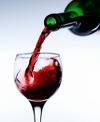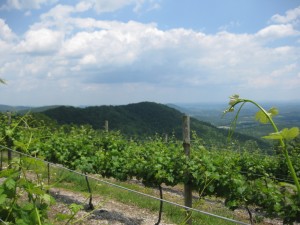Archive for April, 2009
 Old House Vineyards
Old House Vineyards
Bacchanalia
Native French winemaker, Damien Blanchon, has brought his skills to bear in the production of this red blended wine named in honor of Bacchus, and the legendary celebrations held in his honor. A mélange of Chambourcin, Cabernet Franc, Merlot and Tannat, the wine opens with raspberry, cedar and spice aromas and follows on the palate with silky cherry and currant flavors. Aged for 18 months in French and American oak. Pair with stuffed pork chops or grilled blue cheese burgers. Drink now through 2012.
Old House Vineyards is located in a beautifully restored 19th century farmhouse at 18351 Corkys Lane, Culpeper.
The winery is open Monday—Thursday, 1-5 PM
Saturday 11-5 PM
Sunday, Noon to 5 PM
Telephone: (540) 423-1032
Man has fermented grapes into wine for over 7,000 years.
 Imagine the scene. A prehistoric man picks up a rustic bowl filled with wild grapes that, serendipitously, had been left outside his dwelling for a few weeks. It was a unique moment in history. Our ancestor must have tentatively tasted the new wine. And perhaps handed the vessel to his mate to sample. Then, after a few more sips, both of them most assuredly broke into satisfying smiles. From that moment on, the quest to pursue the marriage of yeast and grape has gone on unabated.
Imagine the scene. A prehistoric man picks up a rustic bowl filled with wild grapes that, serendipitously, had been left outside his dwelling for a few weeks. It was a unique moment in history. Our ancestor must have tentatively tasted the new wine. And perhaps handed the vessel to his mate to sample. Then, after a few more sips, both of them most assuredly broke into satisfying smiles. From that moment on, the quest to pursue the marriage of yeast and grape has gone on unabated.
I feel some kinship to that ancient winemaker because the joy of turning grapes into wine is, indeed, gratifying. To create, enjoy and share this special beverage embodies hospitality worldwide.
The process of making wine is not all that difficult. But, making good wine…ahhh, that is a bit more challenging. Today in the United States, there are over 5,500 commercial wineries, not to mention untold thousands of home winemakers. But all of us, amateur and professional enologist, pursue our passion for the love of the finished wine and the joy it brings to those who sip from the glass.
On my HAGARTY CELLARS link I will share stories of my adventures, pitfalls and successes in making wine at home. And who knows, as you follow my experiences you may also be drawn into the alluring pursuit of turning the vine into wine.
 On Tuesday, April 21, 2009, Jean and I were fortunate to host a wine dinner at one of the finest historic inns in Virginia, the Inn at Meander Plantation. Proprietors Suzie Blanchard and Suzanne Thomas have created a most unique bed and breakfast in the heart of the Virginia Piedmont.
On Tuesday, April 21, 2009, Jean and I were fortunate to host a wine dinner at one of the finest historic inns in Virginia, the Inn at Meander Plantation. Proprietors Suzie Blanchard and Suzanne Thomas have created a most unique bed and breakfast in the heart of the Virginia Piedmont.
Colonel Joshua Fry, a member of the House of Burgesses, patented the plantation in 1727, the first in Madison County. Thomas Jefferson was a frequent visitor, as was General Lafayette. To walk the grounds, with the Blue Ridge Mountains as backdrop, is to be taken back to the early years of the birth of our nation.
Our dinner was the culmination of a two-day Inn cooking school. Chef Blanchard and Executive Chef, Alexander Morris, hosted twenty-one guest “students” from points up and down the East Coast, sharing with them the secrets of gourmet cuisine, Virginia style. The entire dinner was prepared with an emphasis on locally produced ingredients. The five-course repast was paired with wines from Rappahannock Cellars.
A particular favorite of the guests was the third course, Pan Seared Rockfish, with Red Pepper and Onion in a White Wine & Orange Butter Pan Sauce, served with Roasted Fingerling Potatoes and Baby Carrots and matched with our 2007 Viognier.
 The Inn’s cooking school program is conducted once a month–on Mondays and Tuesdays–year round. If you are looking for a romantic, and restful excursion back to the early plantation days of Virginia, the Inn at Meander Plantation will not disappoint. A full description of all the Inn’s services and accommodations is available on their website here.
The Inn’s cooking school program is conducted once a month–on Mondays and Tuesdays–year round. If you are looking for a romantic, and restful excursion back to the early plantation days of Virginia, the Inn at Meander Plantation will not disappoint. A full description of all the Inn’s services and accommodations is available on their website here.
Rappahannock Cellars
2006
Cabernet Franc
$ 24
Winemaker Jason Burrus has created a stellar rendition of a Virginia Cabernet Franc, as testified by his Best of Category and Double Gold win at the San Francisco International Wine Competition—one of the most prestigious events in the nation. The wine opens with aromas of raspberry, spice and a veil of smoke and blossoms on the palate with a medley of black currant and mocha. The seamless integration of wine and oak showcases its 15 months of aging in French and American barrels. Pair with Beef Wellington or grilled lamb. Drink now through 2012.
 There’s a new craze sweeping our state–The Virginia Twosome.
There’s a new craze sweeping our state–The Virginia Twosome.
A dance? A card game? A vacation getaway? Two golfers?
My, those were all good guesses. But wrong.
The Virginia twosome rapidly gaining fame is a pair of wine diamonds, Viognier and Cabernet Franc. These are grapes–the first one white and the second one red. And they are increasingly being recognized nationally as Virginia’s contribution to fine wine.
Less you think identifying a geographical area with certain wine grapes is odd, consider the following wine matches: Napa & Cabernet Sauvignon; Mendoza & Malbec; Australia & Shiraz; Burgundy & Pinot Noir; New Zealand & Sauvignon Blanc; Germany & Riesling; Tuscany & Sangiovese. Just to mention a few.
The French call this bond of grape and land, terroir, pronounced tehr-WAHR. It identifies the somewhereness that a wine grape is grown. The climate, the soil, the slope and sun exposure of the vineyard, the seasonal changes–even the trellis systems employed–all contribute to the quality of the fruit produced. Perhaps an easier way to picture what terroir means, is to think of the Georgia Peach. The firm, deliciously sweet, fragrant and juicy summer fruit. It’s not a peach grown elsewhere. It’s a peach that reaches its highest level of aroma and taste simply because it’s grown in Georgia. That’s terroir.
In Virginia, we are fortunate to have two wine grapes that are performing beautifully in both the vineyard and the wine cellar. Let’s take a closer look at the fruit that is changing the landscape of the Old Dominion’s vineyards.
 VIOGNIER
VIOGNIER
As with many French names, this grape can be a bit difficult to pronounce at first. Simply say vee-own-YEA.
The grape hails from the northern Rhone Valley in France and is thought to have originated from the Romans who introduced it into Gaul over 2,000 years ago. It was once widely planted in the Rhone Valley but slipped into obscurity as it became more difficult to grow. During the 1960s, there was less that thirty acres of Viognier planted in all of France, a nation with over two million acres of vineyards. The grape was clearly in decline.
In the mid 1980s, a California winemaker of wide repute, Joseph Phelps, adopted the vine and anticipated it might be the next Chardonnay, which is one of the most popular white wine grapes in the world. Unfortunately, it did not achieve the popularity he had anticipated. Then about fifteen years ago, it was introduced into Virginia’s vineyards. Here it has taken to our terroir like a kitten to catnip.
The Virginia wine produces a medley of luscious aromas and flavors redolent with honeysuckle, peach, pear and melon. It can be vinified in oak or crafted in a clean, crisp style that eschews oak undertones. In either case, its ancient lineage glows with a creamy mouth feel and soft spice finish. It is a wonderful alternative for those drinkers known as ABCers–Anything But Chardonnay.
Perhaps more importantly, Virginia’s Viognier is being hailed in some circles as even better than the French original. Numerous gold medals have been awarded to our state’s viogniers from prestigious competitions across the country. Look for this white wine to gain even further acclaim in the years ahead.
 CABERNET FRANC
CABERNET FRANC
This grape has been the workhorse of red blended wines for centuries. The majority of appellations around the world use the grape to enhance other classic reds. Since it produces a wine somewhat lighter in color and tannins than Cabernet Sauvignon, many Bordeaux reds contain 20% or more of this grape. It is aromatic with a wide range of flavors centered on raspberry, plum, cherry and spice. And its lower but firm acidity produces a food friendly beverage.
The attributes that favor growing the grape in Virginia are its cold hardiness and early ripening traits. Coaxing the best out of a wine grape requires meticulous management of the vineyard, and having inherent strong qualities in the vine itself eases the vineyard manager’s work. Cabernet Franc’s uniqueness is well suited to our state’s soil and climate.
To burnish the grape’s reputation even further, recent DNA testing has revealed that Cabernet Franc, along with Sauvignon Blanc, are the parents of Cabernet Sauvignon. Clearly, the acorn did not fall far from the tree.
In Virginia, many Cabernet Francs are blended with a touch of other reds. For a wine to be labeled the name of a grape it must contain at least 75% of that specific wine. Often you will find our state’s Cabernet Francs contain a dash of Merlot, Cabernet Sauvignon, Petit Verdot or Malbec. This blending strategy mirrors in reverse the technique used in Bordeaux.
As with Viognier, Cabernet Franc has garnered a host of competition medals and awards. We can count on even finer bottlings in the years ahead as our winemakers learn more about showcasing this wine’s unique character.
 So the next time you are visiting one of our local wineries, take the time to linger over this winsome twosome. Experience more fully the magic these two wines are displaying in our state. There’s no need to travel to France or California to experience world-renowned scenery and wine. And the reward for your enjoyable pursuit may be the discovery of your next favorite bottle of wine.
So the next time you are visiting one of our local wineries, take the time to linger over this winsome twosome. Experience more fully the magic these two wines are displaying in our state. There’s no need to travel to France or California to experience world-renowned scenery and wine. And the reward for your enjoyable pursuit may be the discovery of your next favorite bottle of wine.
Published March 26, 2009 in the Culpeper Times.






